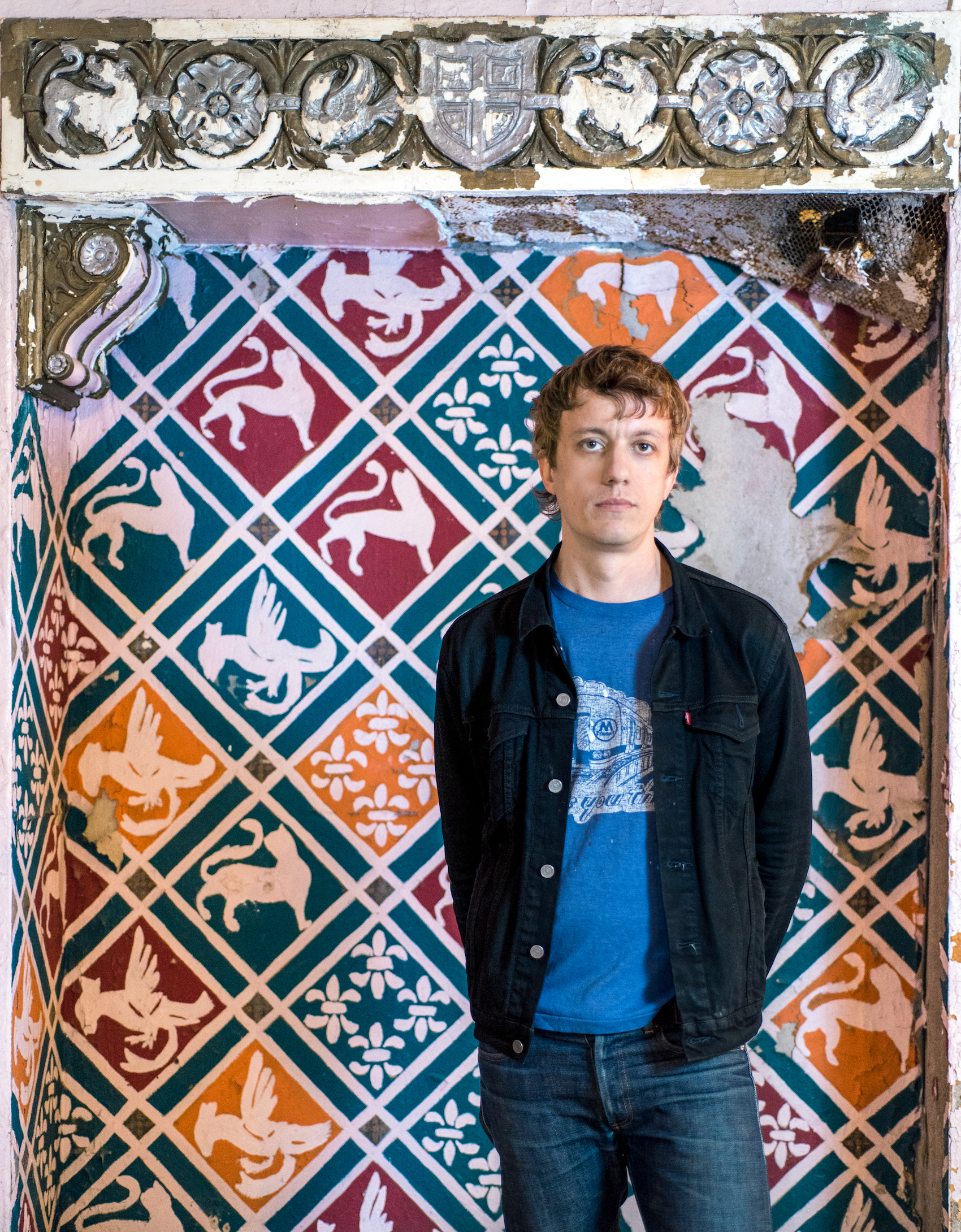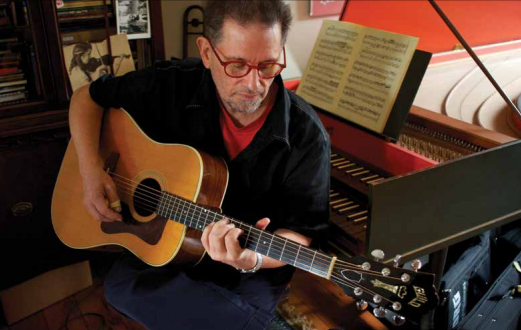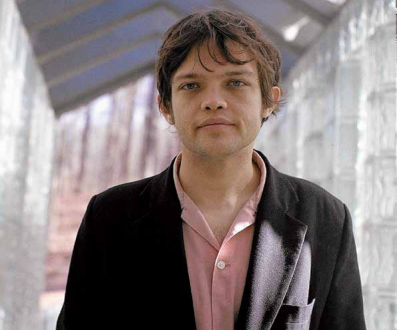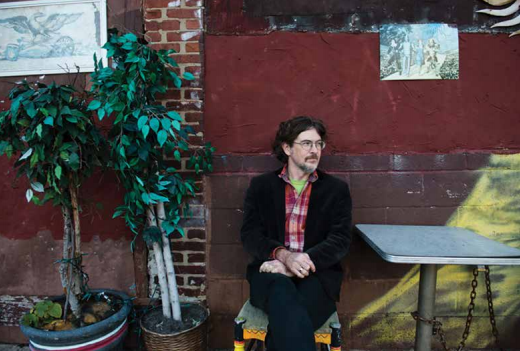Steve Gunn, William Tyler and Chris Forsyth on The New Golden Age of Guitar
 Like professional baseball or FM radio, the guitar has never disappeared from mainstream American culture, nor even lost its power, despite numerous declarations of its demise. “Laptops are the new guitars” is a cliché by now, and while that’s not untrue, it does a disservice to the fact that the early 21st century has turned out to be a golden age for the more traditional of the two instruments, with a new school of dot-connecting players reinventing the seemingly outmoded, vibrating string box on a regular basis.
Like professional baseball or FM radio, the guitar has never disappeared from mainstream American culture, nor even lost its power, despite numerous declarations of its demise. “Laptops are the new guitars” is a cliché by now, and while that’s not untrue, it does a disservice to the fact that the early 21st century has turned out to be a golden age for the more traditional of the two instruments, with a new school of dot-connecting players reinventing the seemingly outmoded, vibrating string box on a regular basis.
With a new aesthetic emerging from the late-‘90s world of indie rock, Clapton is no longer God, as the old graffiti claimed, nor even (or especially) Jimmy Page, Eddie Van Halen, nor any other speed demon. Instead, these new players—on acoustic and electric, on six and 12 strings, loud and quiet—draw from a new pantheon. It privileges the punked guitar tandems at the heart of The Velvet Underground, Television, Sonic Youth, Sun City Girls, and more, admits underground ‘60s heroes (the Grateful Dead chief among them), the influences of minimalism and folds in a torrent of new global pathways, especially from West Africa and the Middle East. Sometimes the guitars groove, but it’s not often dance music.
One major turn can be found in the coronation of the late John Fahey. Playing to small audiences in the ‘60s and until he died in 2001, Fahey was a champion of an elegant folkblues style that he called American Primitive. Syncopated and mysterious and folk-derived, many of the new acoustic players connect back to Fahey’s Takoma Records, whose catalog included Leo Kottke, Indianinfluenced Robbie Basho and more.
The variations are infinite, as vast as any spoken language, a whole alternative guitar universe that shrugs off Rock and Roll Hall of Fame-branded super-session slingers and metalloid “Eruption”-ists. It is an exploding, worldwide conversation, a borderless and relentless post-millennial hunt for new territory by an underground of free-thinking musicians.
On an April Sunday in Brooklyn, the small back room at Union Pool is comfortably full and fully respectful. It’s a conclave of new Primitivists. Headlining is the Boston-based Glenn Jones, a friend, collaborator and champion of John Fahey. A Fahey devotee since the early 1970s, Jones’ playing brings the music to its most loving extreme, each note sounding rich and handcrafted. On the bill is Anthony Pasquarosa, who switches between mystic 12-string fingerpicking and frailing banjo. Though he doesn’t play any this night, he also has a regular handful of Grateful Dead songs in his set, including the “Lady with a Fan” section of “Terrapin Station” stretched to one logical folk destination.
Laura Baird, from a pocket of Philadelphia folkies, provides some spare, Sunday evening banjo. Also playing is Alan Licht, from a whole other lineage of New York avant-players stretching back to the ‘70s. There have always been people experimenting with the guitar, but the audience now seems more vast, the outlets more plentiful. If the crowds are still small and the profits meager, it’s perhaps only because the albums and players have multiplied so quickly. The collapse of the American recording industry hasn’t helped profits, but it has connected many obscure musicians to a network of new audiences.
Beginning a solo career after playing with the Boston band Cul de Sac starting in the late ‘80s, Glenn Jones first noticed the vast mushrooming of players in 2003 in the idyllic Vermont climes of the Brattleboro Free Folk Festival. “It was amazing,” he says, “like a combination of free jazz and avant-folk and all that. [Before that], you’d go to shows and it’d be all guys, but I went to this and it was the first place that I saw women participating.”
Jones encountered the Northampton regulars (like drummer Chris Corsano and the weird-folk-drone-jam supergroups Tower Recordings and Sunburned Hand of the Man), the Garcia-loving strange-stringer Tom Carter, and—most strikingly—a 32-year-old guitarist named Jack Rose. The spark of the Philadelphia scene, who had played in the electric-drone band Pelt, Rose became to John Fahey what Bob Dylan was to Woody Guthrie, absorbing his musical and personal mannerisms in search of his own voice. Jones struck up a close friendship with Rose, 18 years his junior, often touring together until Rose’s untimely death from a heart attack six years later. 
“I don’t want to canonize Jack too much in a way that he would get irritated by, but whenever he ditched [drone-rock band] Pelt and started doing his own thing, that was—in my mind—when that movement started up,” says Cory Rayborn, founder of Three Lobed Recordings, a label as responsible as any for documenting the rich new world. “It was around that time that Ben [Chasny] started doing his thing out in California, too. And then you start to see all the other satellites and things along those lines.” Around this same time, Spin published Byron Coley’s retrospective on Fahey, which Glenn Jones points to as well.
In many ways, Jones still can’t believe the resiliency of American Primitive guitar and its practitioners. “When [Robbie] Basho died [in 1986], none of his records were in print,” Jones says. “CDs were just starting to come out, and I thought, ‘In 10 years, no one’s gonna know who this guy was.’”
It took nearly 20 years, but the Basho revival has come, too. This summer will see the release of Basket Full of Dragons, the second Basho tribute organized by Buck Curran, a guitar maker, one-half of the Maine-based Arborea and a solo artist with his debut album set for release this summer on ESP-Disk’. Already a fan of Indian music when he discovered Basho, Curran says: “I thought of what a beautiful thing it is that [we’d] both separately drawn inspiration from musical branches that are rooted in the same source material.”
Like others, Curran points out the widespread influence of the Internet on music at large. “YouTube has been a major advancement,” he says. “It’s an archival gold mine. From learning to play guitar, to listening to contemporary albums, to rare, live historical performances.”
It’s not a radical opinion so much as a fact: There is more music than ever before, not only because of the long-term accumulation of recordings, but because the amount of music released each year is far greater than ever before, an outgrowth of contemporary recording and distribution technologies. Music that once comprised micro-niches can now find bigger audiences and more practitioners than ever before, albeit with even fewer profits spread over many more musicians.
Labels like California’s Tompkins Square, Brooklyn’s VDSQ and North Carolina’s Three Lobed (home to Jack Rose and many others) turn out new voices on the regular. Among VDSQ’s latest, for example, is the proper debut from North Carolina-based Sarah Louise, who has a new kind of spiraling voice all her own. “What is she doing with her right hand?” Glenn Jones wonders.
“In today’s digital age, the appeal of the natural speaks to certain music fans more than ever,” says VDSQ founder Steve Lowenthal. “In some ways, it can feel like a crucial escape from the constant beeping and alerts of modern life.”
It is perhaps Bhutanese guitarist Tashi Dorji who best exemplifies the excitement of the (mostly) acoustic part of the guitar renaissance. Arriving with a singular new voice on his 2009 solo debut, Dorji creates chaotic improvisations that sometimes, all-too-briefly, open up into lush gardens of tonality. There’s nothing American or folky about it, as much as it’s music in its purest mode, a musician negotiating with his ears and instrument in real time. At any point in the past century, at least, somebody could have made the music that Dorji (or any one of these acoustic guitar players) makes. But they didn’t.
“Never point your guitar at anyone” ranks at No. 6 on Captain Beefheart’s 10 Commandments of Guitar Playing, as translated by Magic Band guitarist Moris Tepper. It’s good advice and seems to cast shade on the guitar-asphallic-symbol school of playing. Most of the advice is more abstract. “Listen to the birds” is No. 1. “That’s where all music comes from.” One agreed-on recognizance of the new guitarists is the pure lameness of the old rock/metal move of wielding guitars like laser-zapping phallic weaponry. Almost none of them could be said to have a signature guitar face.
Flowing between acoustic and electric, guitarists like William Tyler and Steve Gunn are new-model guitar heroes, something above and beyond slingers-for-hire, as they use their guitars for a fully open type of creative communication. In some players, the music event takes on familiar forms, even as it nods back to improv spaces from the past. Sometimes there’s singing. Occasionally there are even big dramatic solos. But no pointing.
Playing with the celestial improv unit GHQ in the early 2000s before launching a mostly solo acoustic career, Gunn “started to feel a little trapped and constrained in what I could do personally and how I was perceived, because there’s such a huge shadow that’s cast around that style. I was trying to be a little more expansive than those parameters. Singing was something I was building up to.” The guitar and its constant motion remain at the center of his newest album, Eyes on the Lines, but the songs now also have words, choruses and big dramatic moments served by Gunn’s own voice. “I was trying to do things that were too complicated, especially singing on top of it,” he says. “I started realizing maybe I can even strum a guitar.”
“I don’t write words and I’m not a good singer, so I’d rather spare the world,” says the Nashville-based William Tyler. An assured and graceful instrumental voice that sometimes sounded like a countrypolitan Jerry Garcia, even before Tyler fell into a prolonged Grateful Dead obsession, his guitar is more like a lead character that appears under a series of shifting circumstances. On 2014’s Lost Colony EP, Tyler met Luke Schneider’s pedal steel on soaring joints of krautrock-Americana. This summer, he pairs up with bassist Darin Gray and Wilco drummer Glenn Kotche on Modern Country, his most wide-ranging set.
Citing Ben Chasny, the acoustic/electric drone-folk hero who has recorded since the late ‘90s as Six Organs of Admittance, as an influence, Tyler says, “I started off with [the idea of a] more holistic thing. I wanted to make homemade, experimental music.” In doing so, he discovered that being a solo guitarist could also be quite practical. “It offered a way of doing [live] stuff without a band.”
“People discover themselves at different rates,” says Chris Forsyth, a Philadelphia-based guitarist who has led a rotating Solar Motel Band since 2013, having previously done time in the experimental group Peeesseye. “I just kept going and found this way of playing.” Most recently, Forsyth has begun to sing, too, but the Solar balance mostly rests on his soaring leads, which find a thrilling spot on the horizon between the fluid Jerry zones and the neon starlight of Television’s Marquee Moon. On The Rarity of Experience, Forsyth finds an excellent foil in Nick Millevoi, another Philadelphia-based player whose own Desertion reveals him as a jazz-drenched electric guitarist who could maaaybe make Frank Zappa cool again. It’s 2016. Anything could happen.
Downstairs in the reconstructed 15th-century French arcade, Sarah Lipstate unravels galaxies with her Fender Jaguar, soaring waves of sound that recall Sonic Youth’s most cosmic moments reduced to only the glorious guitar. Upstairs at the annual New York Guitar Festival, in a room from a monastery once shipped piece by piece over the Atlantic, Earth guitarist Dylan Carlson (a good ol’ Dead freak) peels off solo drone-blues, suggesting that maybe he should be assigned “Morning Dew” the next time someone organizes a Dead tribute. 
Held this year at the Cloisters, a hyperreal Frankenstein of old-world architecture nestled in Manhattan’s Fort Tryon Park, the Guitar Festival’s marathon draws overflow crowds that wind down the stone steps and verandas. Upstairs, William Tyler performs unamplified under a Virgin Mary. Chicago jazzfolk guitarist Ryley Walker is in a chapel, under a giant crucified Christ. “Bummer,” he says, looking up. The new players go side by side with world-class oudists (Simon Shaheen) and the insane rhythms of players like Gyan Riley (son of Terry).
“It’s a punk reaction to the Yngwie [Malmsteen] world,” says David Spelman, who co-founded the festival in 1999. “But these players also have extraordinary technique. I think there are a lot of threads that come together, and a lot of chapters in the story, and result in someone like a William Tyler or a Ryley Walker. If you look at music history, you have an ebb and a flow between diatonicism and chromaticism, or maximalism and minimalism—these things kind of ebb and flow between experimentation and conservatism. Things go through these cycles and what’s old feels new again.”
He continues: “Because of its role in popular music, guitar is an entry point for lots of ideas that come from contemporary classical music and experimenters, whether it’s from the American Primitive side of things or the world of conservatories.”
Most excitingly, though, sometimes what’s new is new. And, right now, that seems like a limitless natural resource.



















